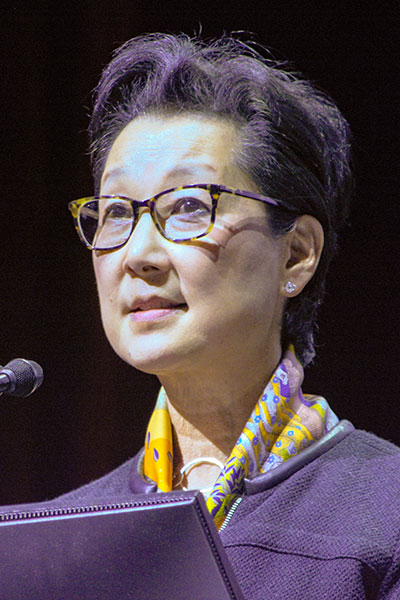The second General Session at the 2024 San Antonio Breast Cancer Symposium® included presentations on studies with potential practice-changing implications — a late-breaking abstract on a CDK4/6 inhibitor-based triplet combination therapy in hormone receptor-positive (HR+) human epidermal growth factor 2-positive (HER2+) metastatic breast cancer following chemotherapy induction for advanced disease and de-escalation approaches in low-risk ductal carcinoma in situ (DCIS) and intermediate-risk breast cancer.
A recording of the session, held Thursday, December 12, is available on demand for registered 2024 SABCS® participants through March 31, 2025, on the virtual meeting platform.
GS2-12: AFT-38 PATINA: a Randomized, Open Label, Phase III Trial to Evaluate the Efficacy and Safety of Palbociclib + Anti-HER2 Therapy + Endocrine Therapy vs. Anti-HER2 Therapy + Endocrine Therapy after Induction Treatment for Hormone Receptor-Positive (HR+)/HER-Positive Metastatic Breast Cancer

Otto Metzger, MD, medical oncologist at the Dana-Farber Cancer Institute, shared potentially practice-changing data from the phase III academic AFT-38 PATINA study, which demonstrated a clinically meaningful improvement in progression-free survival (PFS) with addition of palbociclib to anti-HER2 and endocrine therapy in patients with HR+ HER2+ metastatic breast cancer without disease progression after completing induction chemotherapy.
Approximately 25% to 30% of breast cancers overexpress HER2, and half of the HER2+ tumors co-express estrogen receptors. While anti-HER2 therapy has significantly improved outcomes in patients with HER2- breast cancer, resistance is common.
CDK4/6 inhibition is an established effective therapeutic option in HR+ HER2- disease; notably, palbociclib is approved in this setting based on clinically meaningful PFS improvement.
In AFT-38 PATINA, 518 patients with HR+ HER2+ metastatic breast cancer who had no prior treatment in the advanced setting beyond induction were randomly assigned (1:1) to receive either anti-HER2 therapy and endocrine therapy alone or in combination with palbociclib. Notably, randomization occurred after patients completed chemotherapy induction, to enable assessment of the benefit of adding palbociclib in patients who had complete response, partial response, or stable disease after induction.
Overall, key patient characteristics were balanced between the two arms, including anti-HER2 therapy (trastuzumab plus pertuzumab in most patients), type of endocrine therapy (aromatase inhibitors most commonly and fulvestrant in the remaining patients), and response to induction (over two-thirds had complete or partial response, and the remaining patients had stable disease).
The addition of palbociclib improved investigator-assessed PFS, the primary endpoint, over anti-HER2 plus endocrine therapy alone.
“The median PFS in the control arm of our study is 29.1 months; this far exceeds what we expected,” Dr. Metzger said. “In spite of that, we see a [further] 15.2-month improvement, over a year of [PFS] improvement with the addition of palbociclib.”
The median PFS with the addition of palbociclib was 44.3 months, translating to a 26% reduction in the risk of progression, at a median follow-up of 52 months.
Dr. Metzger called attention to the secondary endpoints of overall response rate (ORR) and clinical benefit rate (CBR), both of which were assessed from randomization onward — the response metrics measure the additional response after induction chemotherapy. Both ORR and CBR were higher with the addition of palbociclib. The overall survival (OS) data were immature at the time of this analysis.
Overall, the safety profile of the addition of palbociclib were consistent with the known adverse events (AEs) associated with this drug, with neutropenia, fatigue, and stomatitis being the most common. Importantly, the rate of treatment discontinuation due to AEs was low, and there were no treatment-related deaths reported.
“Palbociclib added to anti-HER2 and endocrine therapy may represent a new standard of care for patients diagnosed with HR+ HER2+ advanced breast cancer,” Dr. Metzger concluded.
GS2-02: Impact of Tamoxifen Only after Breast Conservation Surgery for “Good Risk” Duct Carcinoma in Situ: Results from the NRG Oncology/RTOG 9804 and ECOG-ACRIN E5194 Trial

Jean L. Wright, MD, Chair of the Department of Radiation Oncology at the University of North Carolina and the Lineberger Comprehensive Cancer Center in Chapel Hill, presented a combined analysis of the NRG Oncology/RTOG 9804 and ECOG-ACRIN E5194 studies, evaluating the value of radiotherapy in reducing the risk of ipsilateral breast recurrence (IBR) after breast-conserving surgery for patients with low-risk DCIS.
The analysis showed that adjuvant tamoxifen treatment reduced overall IBR and invasive IBR, but not DCIS IBR or contralateral breast events, in patients with “good risk” DCIS — low/intermediate-grade, with tumor size ≤2.5 cm and surgical margins ≥3 mm — treated without radiotherapy after breast conserving surgery.
Dr. Wright reviewed the 15-year results from the NRG/RTOG 9804 study, which showed that radiotherapy reduced IBR in a “good risk” DCIS population.
“This study identified that while radiation therapy does reduce the risk of IBR, omission of radiotherapy is also a reasonable option for patients with these good risk DCIS characteristics. The impact of endocrine therapy has been less well studied, especially in the modern era,” Dr. Wright said.
To address the role of endocrine therapy in the “good risk” DCIS setting, Dr. Wright and colleagues combined data for patients with low/intermediate-grade DCIS, with tumor size ≤2.5 cm, who received tamoxifen or no tamoxifen in NRG/RTOG 9804, a randomized trial, and ECOG-ACRIN E5194, a prospective observational study. The analysis included 878 patients, 378 of whom had received tamoxifen.
Tamoxifen use significantly reduced 15-year IBR, from 19% to 11.4%. Tamoxifen had a similar statistically significant impact on 15-year invasive IBR, with a reduction from 11.5% in the tamoxifen-treated group to 6% in patients who did not receive tamoxifen. Endocrine therapy with tamoxifen had no impact on DCIS IBR or contralateral breast events.
These data suggest that “the decision to recommend endocrine [therapy in the setting of omission of radiotherapy] or radiation therapy should be part of a shared decision process,” Dr. Wright said.
She added that ongoing studies that integrate molecular profiling for informing radiotherapy decisions should also evaluate the impact of endocrine therapies, particularly in patients with “good risk” DCIS not receiving radiation.
GS2-03: Does postmastectomy radiotherapy in ‘intermediate-risk’ breast cancer impact overall survival? 10-year results of the BIG 2-04 MRC SUPREMO randomized trial: on behalf of the SUPREMO trial investigators

Patients with intermediate-risk breast cancer had similar rates of 10-year OS regardless of the use of chest wall irradiation after mastectomy, according to data from the randomized BIG 2-04 MRC SUPREMO study shared by Ian Kunkler, MD, Professor of Clinical Oncology at the University of Edinburgh.
Based on data from nearly three decades ago, post-mastectomy chest wall irradiation became the standard of care for patients with T3 tumors who had ≥4 positive nodes. “But there were concerns about the quality assurance,” said Dr. Kunkler.
“On the basis of this uncertainty, post-mastectomy radiotherapy was made a research priority of the [National Institutes of Health] in the U.S. in 2000,” Dr. Kunkler said.
To evaluate the role of post-mastectomy radiotherapy, the SUPREMO study enrolled patients with intermediate-risk breast cancer — those with breast tumors 50 mm or less across (pT1-2) and one to three positive axillary lymph nodes (N1); breast tumors larger than 50 mm across (pT3) and node-negative disease (N0); or breast tumors larger than 20 mm but no larger than 50 mm across (pT2), N0 disease, and grade 3 histology and/or lymphovascular invasion — who had undergone a simple mastectomy.
Dr. Kunkler presented data for the primary endpoint, OS at 10 years; among 1607 patients, the OS was comparable between the groups — 82% in the 799 who did not receive radiotherapy and 81.4% in the irradiated group. Although there was a relative risk reduction in chest wall recurrence rates with chest wall irradiation, the absolute difference was small, with a 2% difference in 10-year chest wall recurrence rates in the irradiated and non-irradiated groups. Dr. Kunkler noted that this difference was not clinically meaningful.
Dr. Kunkler also shared findings for key secondary endpoints, disease- and metastasis-free survival, neither of which differed between the irradiated and non-irradiated groups.
Based on the lack of improvement of 10-year OS with adjuvant chest wall irradiation in patients with 1-3 positive nodes or pN0 with other risk factors treated with optimal systemic therapy, Dr. Kunkler concluded, “Adjuvant chest wall irradiation should be omitted in most patients meeting eligibility criteria for SUPREMO.”
GS2-05: Early Oncologic Outcomes Following Active Monitoring or Surgery (+/- Radiation) for Low-Risk DCIS: the Comparing an Operation to Monitoring, with or without Endocrine Therapy (COMET) Study (AFT-25)

“The treatment for nearly all patients who are diagnosed with DCIS is surgical excision plus or minus radiotherapy to prevent progression to invasive cancer. Emerging data show that DCIS may, but does not always, progress to invasive cancer, presenting a potential opportunity for active monitoring,” in patients with low-risk DCIS, who have good prognosis, said E. Shelley Hwang, MD, MPH, the Mary and Deryl Hart Distinguished Professor of Surgery, Vice-Chair of Research in the Department of Surgery, and a Professor of Radiology at the Duke University School of Medicine.
Dr. Hwang shared findings from COMET, a prospective randomized noninferiority study comparing guideline-concordant care to active monitoring in patients with low-risk DCIS. COMET randomly assigned 995 patients with grade 1 or 2, HR+, HER2- DCIS with no evidence of invasive cancer to undergo active monitoring (n=484) or receive guideline-concordant care consisting of surgery with or without adjuvant radiation (n=473). Patients in the active monitoring arm could elect to have surgery at any time, and surgery was required if the tumor showed signs of invasive progression. Endocrine therapy was allowed for patients in either arm.
Notably, nearly a third of the patients did not adhere to their arm allocation, with more patients favoring active monitoring. To account for allocation non-adherence, both per-protocol intent-to-treat (ITT) analyses and an additional analysis of the as-treated population were conducted.
The primary endpoint, two-year cumulative rate of invasive IBR, met the noninferiority threshold; the invasive IBR was 5.9% in the guideline-concordant care arm and 4.2% in the active monitoring arm.
In the as-treated analysis, which included 673 patients who adhered to their assigned treatment, the two-year invasive IBR was 8.7% in the guideline-concordant care arm and 3.1% in the active monitoring arm.
Dr. Hwang noted that 71.3% of patients received endocrine therapy in the active monitoring arm compared to 65.5% in the guideline-concordant care arm. In endocrine therapy-treated patients, the invasive IBR was 7.15% in the guideline-concordant care arm and 3.21% in the active monitoring arm.
“At two years, women with low-risk DCIS randomized to active monitoring had a non-inferior rate of invasive cancer in the ipsilateral breast compared to those randomized to guideline concordant care. The short-term results are encouraging, but we will need additional follow-up to determine the long-term feasibility and acceptability of this approach,” Dr. Hwang concluded.
The results of the COMET study presented by Dr. Hwang were published Thursday in the Journal of the American Medical Association.
GS2-06: Patient-Reported Outcomes Following Active Monitoring or Surgery (+/- Radiation) for Low-Risk DCIS in the Comparing an Operation to Monitoring, with or without Endocrine Therapy (COMET) Study (AFT-25)

In addition to the clinical outcomes of invasive IBR from COMET shared by Dr. Hwang, today’s General Session also included a presentation on patient-reported outcomes (PROs) from this study, which were presented by Ann H. Partridge, MD, MPH, Interim Chair of the Department of Medical Oncology at Dana-Farber Cancer Institute and a professor at Harvard Medical School.
Dr. Partridge thanked the organizing committee for selecting the abstract for presentation, as “a testament to their dedication to infuse the patient voice into the conference.”
She added, “Women with a history of DCIS have been documented to have an overall favorable health-related quality of life (QoL) in long-term follow-up. However, there are well-documented rates of reduced vitality and mental health concerns.” These include heightened anxiety and fear of recurrence, as well as DCIS treatment-related symptoms such as persistent pain and arm symptoms.
The PROs were a prespecified secondary endpoint in COMET; PRO comparison was conducted by group using prospectively collected validated questionnaires, administered in person or virtually, at enrollment, 6, 12, and 24 months. Both ITT and sensitivity analyses were carried out to evaluate differences in PROs by group over time.
The PRO findings showed that, overall QoL, anxiety, depression, breast cancer worries, and symptom trajectories were comparable between patients who received guideline-concordant care and those who underwent active monitoring, with no evidence of substantial negative impact of one approach over the other at two years.
Sensitivity analyses of participants who adhered to their assigned arm allocation confirmed these findings. In general, QoL, anxiety, and depression did not differ by group over time, with only some symptoms, such as arm problems and pain varying between baseline and by group.
Based on the COMET findings, Dr. Partridge concluded, “For select women considering active monitoring or guideline-concordant care for low-risk DCIS, both strategies appear to have a limited impact on the average lived experience of these patients in the short term.”
The PRO findings from COMET were published Thursday in the JAMA Oncology.
Following are additional abstracts presented during Thursday’s General Session 2:
GS2-01: Exclusive endocrine therapy or radiation therapy in women aged 70+ years with luminal-like early breast cancer (EUROPA): preplanned interim analysis of a randomized phase 3 trial.
GS2-07: No axillary surgery versus axillary sentinel lymph node biopsy in patients with early invasive breast cancer and breast-conserving surgery: Final primary results of the Intergroup-Sentinel-Mamma (INSEMA) trial.
GS2-09: Overweight, obesity, and prognosis in 206,904 women in the Early Breast Cancer Trialists’ Collaborative Group (EBCTCG) database.
GS2-10: A long-term image-derived AI risk model for primary prevention of breast cancer.
GS2-11: APOBEC3 mutagenesis induces resistance-promoting genomic alterations in breast cancer.
Access the 2024 SABCS® virtual platform
Watch any sessions you’ve missed and stay connected with fellow attendees in the online platform of the 2024 San Antonio Breast Cancer Symposium®. Recordings of sessions will be available on demand for registered 2024 SABCS® participants until March 31, 2025.

